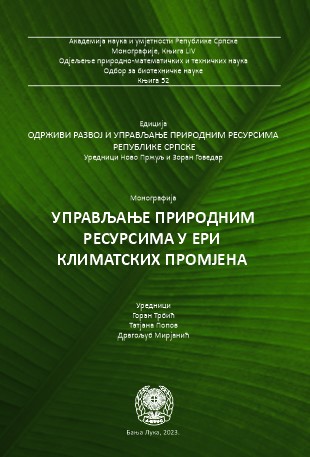Contemporary Climate Change in Montenegro
DOI:
https://doi.org/10.7251/EORU2308369BKeywords:
Temperature, precipitation, trend, climatic periods, MontenegroAbstract
The Mediterranean area, including the Western Balkans, is one of the world’s most vulnerable to climate change. Many papers point out that the Mediterranean region has become warmer, more arid and with more frequent extreme weather events (high temperatures, droughts, heavy short-term rains, floods, etc.) since the middle of the 20th century, compared to the average global situation, in general. The results of the projections for the Mediterranean indicate that this trend will continue throughout the 21st century. This is a general picture of events and projections of climate change for the entire Mediterranean area, but in recent times the importance of researching smaller spatial units, subregions and individual locations of the Mediterranean has been emphasized. Second, given that the 1991‒ 2020 climate period has recently ended, the World Meteorological Organization (WMO) has recommended the use of that reference period, that is, new climatic normals in the analysis of climate element deviations. Taking into account the two mentioned facts (importance of research of smaller spatial units of the Mediterranean region and taking into account the WMO recommendation regarding the use of the new reference climate period 1991‒ 2020), this paper aimed to present the results of temperature and precipitation changes in Montenegro. Data from 10 meteorological stations, evenly distributed over the territory of the country, were used in the period 1951‒2020, as part of the Western Balkans and the Mediterranean, and the analysis included annual and daily values of the two mentioned climatic elements. When it comes to precipitation, the annual sums do not show significant changes in the observed 70-year period (1951‒2020). Changes in precipitation range from -2,3% per decade in Herceg Novi to 1,8% per decade in Rožaje. Year-on-year fluctuations are noticeable, which are common for precipitation, but we cannot talk about the aridization of Montenegro, and it should be expected in the conditions of domination of the anthropogenic greenhouse effect. The trend of annual precipitation shows a certain regionalization, namely that the southwestern and western part of Montenegro registers a decrease in precipitation (Herceg Novi, Cetinje and Nikšić), and the rest of most of the country slightly increases. If we look only at the last 30-year period (1991‒2020), the trend calculations showed that only the station Bijelo Polje registers a negative trend (-4,7% per decade), while at all other stations there was an increase in annual precipitation, the positive trend is up to 9,9% per decade (Ulcinj). In most parts of Montenegro, the annual number of wet (Rd ≥ 10 mm) and very wet days (Rd ≥ 20 mm) does not show significant changes. The only exceptions are Cetinje and Rožaje, where the number of days with Rd ≥ 10 mm decreased (-2,1 days per decade) and Rd ≥ 20 mm increased (0,7 days per decade), and in both places these changes are significant at the level of hypothesis correctness of 95% (risk level p < 0,05). The only precipitation index that indicates the aridization of Montenegro is the number of dry days (SD), because the calculation results showed that during the observed period the number of SD (Rd < 1 mm) increased along the trend line in all observed places. In most parts of the country there was a significant increase in the number of SD (trend is in a range of 2,0‒2,9 days per decade). Regarding changes in thermal conditions, the trend of average annual temperature indicates that there is significant warming in Montenegro, ranging from 0,13 °C per decade in Herceg Novi and Cetinje to as much as 0,70 °C per decade in Rožaje. For the last 30-year period (1991‒2020), the obtained results indicate a more intense warming in relation to the entire observed period, in general. During the previous 30 years, the most intensive trend of increasing average annual temperature was registered in places in the northeast of Montenegro: Bijelo Polje 1,02 °C per decade and Rožaje 0,85 °C per decade. Temperature indices also indicate an increase in temperature. The increase in the number of summer and tropical days, as well as tropical nights, and the decrease in the number of frost and ice days, clearly indicates that there is a tendency of warming in Montenegro in the previous 70 years (1951‒2020). Thus, all considered temperature indices indicate a warmer climate. Finally, a simple difference was used to determine the quantitative magnitude of temperature and precipitation changes between the last two climate periods: 1991‒2020 (new climate normal) and 1961‒1990 (old climate normal). On an annual basis, previous results have shown that the new climatic normals (1991‒ 2020) have almost the same values as the previous ones (1961‒1990). However, the analysis of all temperature parameters indicates that the new climate normals are „warmer“ compared to the previous ones. For example, in relation to the old climatic norm (1961‒1990), the average annual temperature for the period 1991‒2020 it is higher in Podgorica by 1,1 °C, and in Žabljak by 1,3 °C. Has the climate of Montenegro changed? Simply put, the climate of Montenegro has become warmer, but not more arid or humid, that is, nothing worrying is happening with the amount of precipitation and the number of considered precipitation days.
